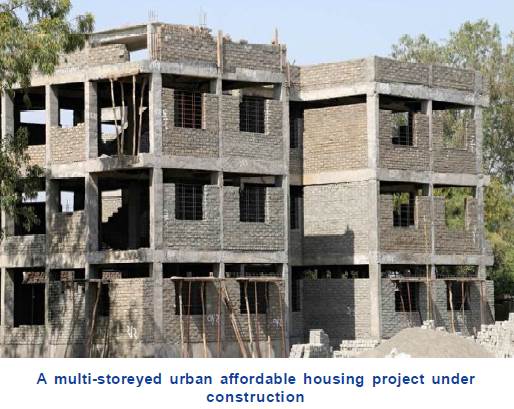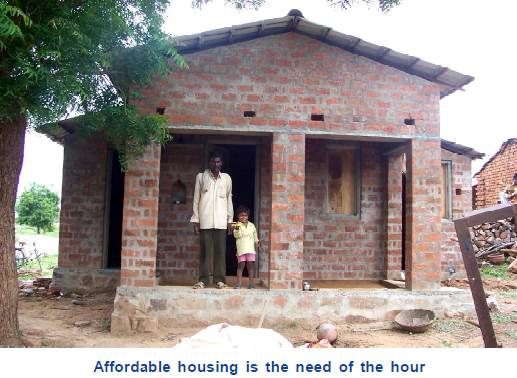|
An Evaluation of Pradhan
Mantri Awas Yojana U rban Affordable Housing – Need of the HourA demographic trend reveals that India is on the verge of massive urbanisation over the next couple of decades. Every year, more than one crore people relocate to urban areas in India and the nation’s total urban population is expected to reach about 81 crore by 2050. Housing, a basic need for humans, will play a critical role in accommodating the high urban growth in India. According to studies conducted by the Ministry of Rural Development and the Ministry of Housing and Urban Poverty Alleviation, it is estimated that almost a quarter of Indian households lack adequate housing facility. However, several structural issues such as limited availability of raw materials, a high gestation period of housing projects, spiralling land and construction costs, limited and expensive capital, high fees and taxes, unfavourable development norms and low affordability by Economically Weaker Section (EWS) and Lower Income Group (LIG) households prove to be hurdles that restrict the desired growth in housing stock in India with respect to housing demand. The central government recognises the importance of the housing issue in the nation and launched a massive campaign that promises to provide housing to all its citizens by the year 2022. Housing for All (2022), rechristened as Pradhan Mantri Awas Yojana (PMAY), according to some estimates, would require the construction of about 11 crore houses with investments of over two trillion US Dollars. Most of the housing development will need to be done for EWS/LIG households, primarily in urban areas, whose income is less than two lakh Rupees per annum. A report by a leading consultancy also reveals that it is the urban affordable housing that will require the central and state governments’ renewed focus, as this segment may need almost half of the total investments envisaged. In order to achieve this, the government ought to evaluate requisite policies and regulations promoting better coordination between housing stakeholders, conduct a thorough analysis of locally available and relevant building materials and sustainable construction technologies, delegate power to urban local bodies, mandate a reduction in project gestation period, introduce rationalisation of fees and taxes, relook at development norms, empower EWS/LIG household and take steps for reduction in project cost and schedule overruns. Convergence of Policies Under the PMAY, launched in 2015, two crore houses are targeted to be built for the EWS/LIG segment in urban areas by the year 2022, coinciding with the seventy-fifth year of India’s independence from colonial rule. As part of this urban housing mission, the central government will provide an assistance in the range of one lakh to two and a half lakh Rupees per house under different components of the scheme including in-situ redevelopment of slums using land as resource, credit-linked subsidy scheme and affordable housing in partnership and beneficiary-led individual construction/improvement. With the announcement of lists under the Smart City Mission, AMRUT and PMAY, there has been an effort to converge the implementation of the three schemes. The nine states that have identified 305 cities for housing for urban EWS/LIG also account for 26 smart cities and 136 AMRUT cities. Of these, the Smart City Mission, AMRUT and Housing Missions will be implemented in 25 smart city aspirants enabling convergence of schemes and resources of state and central governments. Evaluation of Pradhan Mantri Awas Yojana Usage of Government Land: This policy tries to leverage government land occupied by ‘squatters’ in a very limited manner. It tries to free that land by separating it into two components - one for affordable housing and the other for commercial construction. However, it would have been better if there was a clause to make government bodies vacate vast pieces of unoccupied and unused land that is under suboptimal use and not utilised for mass housing. There is likely to be considerable resistance from the public bodies against any such move. Hence, the proposed policy of usage of occupied government land by slum dwellers in itself can be seen as the first step to a more radical but necessary measure of making the government bodies relinquish the unoccupied piece of land, or to put it to optimal use. Land available with the government could have been directly used in development of affordable housing projects instead of freeing it in the market. This way, the supply for affordable housing units will increase. Land under Litigation, Disputes and Property Right
Issues: PMAY tries to leverage the private land under dispute by
providing higher Floor Space Index (FSI) to the private stakeholders
while simultaneously providing for affordable housing in the same. It
aims at regularising the unauthorised colonies, providing and improving
basic municipal services such as roads, sanitation, sewerage, water
services and electricity in these areas and a general improvement in the
infrastructure. However, the policy is silent on many aspects of
property/tenure rights of the people currently living in slums. The
policy does not try to resolve the property rights problems that is one
of the primary reasons for poor conditions of the ex Restrictive Land Transfer Policies: The PMAY aims to address the problem of convoluted land transfer policies and difficult process of changing land use from agricultural to non-agricultural. The policy accounts for easier clearance of various permissions and deemed Non-Agricultural (NA) permission. This is a significant step in the direction of removing the bottleneck between land occupation and land development. However, the overall abolition of NA Clearance would have removed one major perversity in urban land markets that increases the cost of land for housing and urban use. FAR Norms: The policy tries to provide for a higher Floor Area Ration (FAR) in public and private lands where there is a provision for affordable housing construction. This will serve as an incentive for private players to develop the land for commercial purposes, and at the same time develop housing solutions for the EWS/LIG section which are affordable, regulated and have access to proper municipal facilities. However, the policy does not address the problem of a higher FAR in general. This essentially means that the policy does not resolve the land supply constraint due to lower FAR in any way. Hence, the policy will have a low impact in reducing the property prices in any significant manner. Land Use Policies: The policy is silent on the blanket approach by the government/local bodies in deciding the land use policies. Conclusion There is no doubt that the Government of India has taken strides in the right direction to make housing for all a reality. However, the scale of the problem requires more radical thinking on the part of the government in its bid to include the private sector and provide an enabling ecosystem to give the much needed impetus to affordable housing development in the country. As exemplified by some states, adequate policy support from state governments is a vital cog in the wheel. In addition, role of other stakeholders such as micro-credit organisations, state governments, financers and end - users are equally, if not more, important. The adoption of a more social mindset among private developers that looks beyond profit may provide innovative and scalable business models for affordable housing. Although affordable housing for all in India still has a great distance to cover; an integrated and holistic approach from the concerned stakeholders would help the country in realising the daunting challenges. ■ Rohan Jain
Endnotes 1 As on Jan 2014, IEA PVPS) |

 isting slums.
isting slums.